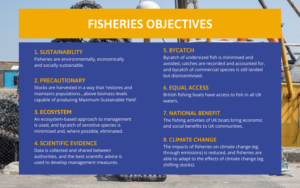FROM BILL TO ACT: UNDERSTANDING THE FISHERIES ACT 2020
February 1, 2021
4-5 minute read
The UK’s departure from the EU’s Common Fisheries Policy was a key part of the Brexit campaign, and now it has become reality. The UK now has its own fisheries legislation, enshrined in law as the Fisheries Act 2020. We work with many clients on a range of projects in the fisheries sector, and so understanding the intricacies of the new legislation is paramount. This guide – written by policy whizz Jacob – takes you through the key parts of the Act, and what they mean for UK fishermen and the marine environment.
ONE ACT, EIGHT AIMS
The Fisheries Act 2020 begins by setting out eight broad objectives- what it ultimately intends to achieve. The eight objectives are:

The Fisheries Act is a framework act, and does not set out how these objectives will be achieved – rather, it delegates this to the UK’s four national fisheries authorities: the Marine Management Organisation (MMO) for England, Scottish Ministers, Welsh Ministers, and the Northern Ireland department. Their collective job is to produce a Joint Fisheries Statement (JFS), which will lay out how these objectives will be met. The four authorities will be working to develop this JFS over the next two years.
SO, WHAT EXACTLY IS THE JOINT FISHERIES STATEMENT?
The Joint Fisheries Statement (JFS) will cover a number of key aspects of fisheries management. It will lay out how each fishing administration will share out quota between its fishing vessels and Producer Organisations, and will come up with specific fisheries management plans for each fish stock or fishing area, which will explicitly aim to keep stocks at a healthy level or help them recover.
There are good reasons why the Fisheries Act doesn’t tackle the fisheries objectives itself but rather places the responsibility on the fisheries authorities.
Firstly, the majority of fisheries policy is devolved – meaning the home nations have control over key aspects of policymaking for fisheries in their own waters. Each fishing administration understands its own needs best, after all, and so it makes sense for the responsibility for developing fisheries management policies to sit outside of Westminster.
Secondly, it means that fisheries policy can be flexible and adaptive. Fish stocks are known to ‘just keep swimming’, and the fishing industry itself is also highly dynamic. This dynamism needs to be reflected in policy. In fact, one of the main criticisms of the Common Fisheries Policy was its lack of flexibility, which meant that fishermen could find themselves having to abide by quota shares that were set out decades ago. The JFS has the potential to be more flexible – it will be able to be modified at any time as long as there’s supporting evidence for doing so, and will also be reviewed at least once every six years. These reviews and amendments will be accompanied by public consultations, which means that fishing organisations, environmental groups, and other parties should be able to have their say.
There will be a few decisions kept centrally rather than delegated out to the Home Nations. These will be laid out in a Secretary of State Fisheries Statement (SSFS) which will accompany the JFS. These central responsibilities will have implications for all fisheries, and include setting the UK’s overall fishing quotas, and sharing them between the four fishing administrations. It also involves overseeing the UK’s international obligations concerning matters such as conservation, as well as broad-stroke improvements for the fishing industry such as opportunities for commercial development or improved traceability.
LICENCES AND QUOTAS
Almost all fishing in UK waters requires a licence under the UK Fisheries Act, whether it’s a UK vessel, an EU vessel, or any other. These licences are granted by the relevant fishing authority and are specific to the area, type of fish, and other factors. Foreign fishing vessels are only allowed to enter UK waters if they have the right licence, or for some other internationally agreed purpose. Penalties for breaking the rules include fines, licence disqualification, and seizure of fish and fishing gear.
You can only get a fishing licence if you have the right quota, which you get from the relevant fishing authority – who in turn get their quota from the Secretary of State. A lot of things factor into decisions for quota allocation: it must bear in mind environmental impact, history of compliance, the contribution of fishing to the local economy, and historic catch levels. It must also incentivise the use of selective fishing gear and more eco-friendly fishing techniques.
The UK will still be using the Landing Obligation from the Common Fisheries Policy, which states that fishermen must land everything they catch (with a few exceptions), even if it exceeds their quota for the particular species. Though not a perfect system, this prevents discards and creates an incentive for fishing to become progressively more selective and avoid bycatch as much as possible.
WHAT HAPPENS NEXT?
Though the Joint Fisheries Statement will eventually underpin fisheries management in UK waters, it’s going to take a good couple of years to get it all together. Until then, the four fisheries authorities will be publishing individual fisheries management plans to tide us over, which will be what the fishing industry uses for the next two years.
There are still a lot of open questions about what UK fisheries management will ultimately look like. Not only is there the JFS to create, but the EU-UK Trade and Cooperation Agreement (Brexit Bill) has also set a six-year ‘adjustment period’, after which access of EU vessels to UK waters is again open for negotiation, and may affect UK quota allocations. Until then, fishermen will be adapting to the changes already made, and keeping a close eye on how the ongoing changes may impact them in the future.
– – –
What are your thoughts on the Fisheries Act 2020? Let us know in the comments!
This blog was adapted from a blog originally written by Jacob in his role working for the APPG on Fisheries Secretariat.
